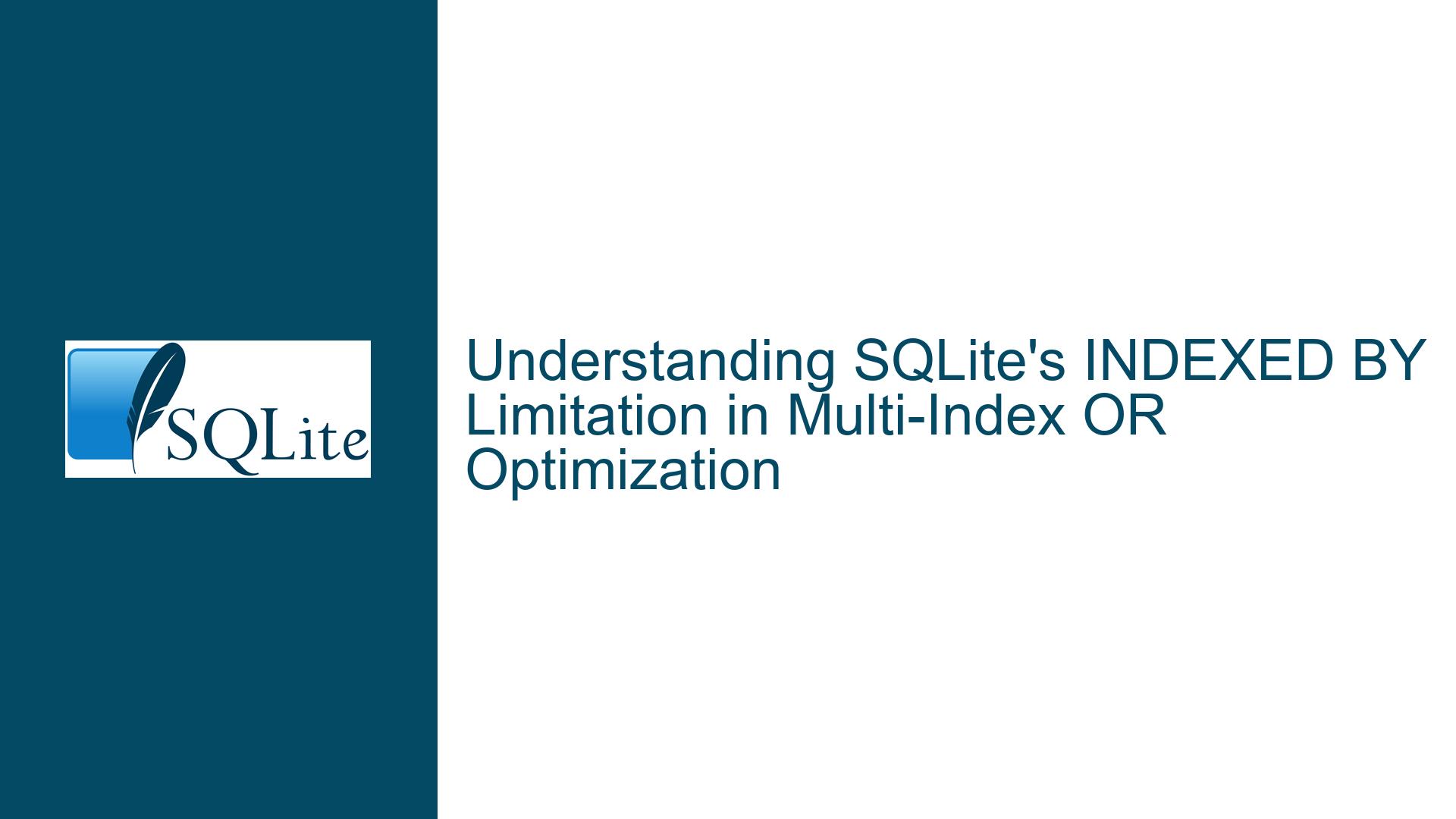SQLite’s INDEXED BY Limitation in Multi-Index OR Optimization
Issue Overview: SQLite’s INDEXED BY Clause and Multi-Index OR Optimization
SQLite is a powerful, lightweight database engine that excels in many scenarios, particularly in embedded systems and applications where simplicity and efficiency are paramount. One of its key features is the ability to optimize queries using indexes, which can significantly improve performance. However, there are nuances in how SQLite handles certain query optimizations, particularly when it comes to the INDEXED BY clause and its interaction with OR-connected terms in the WHERE clause.
The core issue revolves around the INDEXED BY clause, which allows developers to explicitly specify which index SQLite should use for a particular query. This can be useful in scenarios where the query planner might not choose the most optimal index, or where the developer has specific knowledge about the data distribution that makes a particular index more efficient. However, the INDEXED BY clause has a limitation: it does not support specifying multiple indexes for OR-connected terms in the WHERE clause.
In SQLite, when a query contains OR-connected terms in the WHERE clause, the query planner can, under certain conditions, use an index for each OR-connected term. This is known as the OR-by-UNION optimization, where SQLite effectively treats each OR-connected term as a separate query and then combines the results using a UNION operation. This optimization can lead to significant performance improvements, especially when each OR-connected term can benefit from a different index.
However, the INDEXED BY clause does not currently support this multi-index OR optimization. This means that if a developer wants to force SQLite to use specific indexes for each OR-connected term, they cannot do so using the INDEXED BY clause. This limitation has led to questions about whether this is an oversight or if there are technical reasons behind this design decision.
Possible Causes: Why INDEXED BY Does Not Support Multi-Index OR Optimization
The limitation of the INDEXED BY clause in supporting multi-index OR optimization is not an oversight but rather a deliberate design choice. There are several reasons why this limitation exists, and understanding these reasons can provide insight into the trade-offs involved in SQLite’s query optimization strategies.
1. Complexity of Query Planning: SQLite’s query planner is designed to be lightweight and efficient, making it suitable for environments where resources are limited. Supporting multi-index OR optimization within the INDEXED BY clause would add significant complexity to the query planner. The planner would need to handle multiple indexes simultaneously, manage the interactions between them, and ensure that the resulting query plan is both correct and efficient. This added complexity could lead to increased overhead and potentially slower query planning times, which would be counterproductive in many use cases.
2. Potential for Suboptimal Query Plans: Allowing the INDEXED BY clause to specify multiple indexes for OR-connected terms could lead to suboptimal query plans. The query planner’s ability to choose the best index for each OR-connected term is based on its understanding of the data distribution and the selectivity of each term. If a developer were to manually specify multiple indexes, they might inadvertently choose indexes that are not optimal for the query, leading to slower performance. The query planner’s automatic index selection is generally more reliable, as it takes into account statistical information about the data.
3. Limited Use Cases: The scenarios where manually specifying multiple indexes for OR-connected terms would be beneficial are relatively rare. In most cases, the query planner’s automatic index selection is sufficient to achieve good performance. The additional complexity and potential for suboptimal query plans make the feature less attractive from a cost-benefit perspective. SQLite’s design philosophy emphasizes simplicity and reliability, and adding support for multi-index OR optimization in the INDEXED BY clause would not align well with these principles.
4. Technical Limitations: There may also be technical limitations that make it difficult to implement multi-index OR optimization within the INDEXED BY clause. For example, the current implementation of the INDEXED BY clause is tightly integrated with the query planner’s index selection logic. Extending this to support multiple indexes would require significant changes to the query planner’s architecture, which could introduce new bugs and compatibility issues.
Troubleshooting Steps, Solutions & Fixes: Working Around INDEXED BY Limitations
While the INDEXED BY clause does not support multi-index OR optimization, there are several strategies that developers can use to work around this limitation and achieve similar results. These strategies involve understanding the underlying query optimization techniques and leveraging SQLite’s features to achieve the desired performance.
1. Use OR-by-UNION Optimization Manually: One of the most effective ways to work around the INDEXED BY limitation is to manually implement the OR-by-UNION optimization. This involves breaking down the query into multiple subqueries, each targeting a specific OR-connected term, and then combining the results using a UNION operation. By doing this, you can ensure that each subquery uses the appropriate index, effectively achieving multi-index OR optimization.
For example, consider a query with the following structure:
SELECT * FROM my_table
WHERE (column1 = 'value1' OR column2 = 'value2');
To manually implement OR-by-UNION optimization, you can rewrite the query as:
SELECT * FROM my_table WHERE column1 = 'value1'
UNION
SELECT * FROM my_table WHERE column2 = 'value2';
In this rewritten query, each subquery can benefit from an index on column1 and column2, respectively. This approach allows you to achieve multi-index OR optimization without relying on the INDEXED BY clause.
2. Leverage Composite Indexes: Another strategy is to use composite indexes, which are indexes that span multiple columns. If the OR-connected terms in your query involve columns that are frequently queried together, a composite index can be an effective way to improve performance. While this approach does not directly address the INDEXED BY limitation, it can reduce the need for multi-index OR optimization by providing a single index that covers multiple columns.
For example, if you frequently query column1 and column2 together, you can create a composite index:
CREATE INDEX idx_column1_column2 ON my_table(column1, column2);
This index can be used to optimize queries that involve both column1 and column2, reducing the need for separate indexes and potentially eliminating the need for multi-index OR optimization.
3. Analyze and Optimize Query Plans: SQLite provides tools for analyzing and optimizing query plans, such as the EXPLAIN QUERY PLAN statement. By using these tools, you can gain insight into how SQLite is executing your queries and identify opportunities for optimization. For example, you can use EXPLAIN QUERY PLAN to determine whether SQLite is using the expected indexes and whether the OR-by-UNION optimization is being applied.
For example, to analyze the query plan for the original query, you can use:
EXPLAIN QUERY PLAN
SELECT * FROM my_table
WHERE (column1 = 'value1' OR column2 = 'value2');
This will provide detailed information about how SQLite is executing the query, including which indexes are being used and whether the OR-by-UNION optimization is being applied. Based on this information, you can make informed decisions about how to optimize the query, such as by manually implementing OR-by-UNION optimization or creating composite indexes.
4. Consider Alternative Database Engines: While SQLite is a powerful and versatile database engine, it may not be the best choice for every use case. If your application requires advanced query optimization features, such as multi-index OR optimization, you may want to consider alternative database engines that offer more advanced query planning capabilities. For example, PostgreSQL and MySQL both support more sophisticated query optimization techniques, including the ability to use multiple indexes for OR-connected terms.
However, it’s important to weigh the benefits of these advanced features against the simplicity and lightweight nature of SQLite. In many cases, the performance gains from using a more advanced database engine may not justify the additional complexity and resource requirements.
5. Submit Feature Requests or Patches: If you believe that the INDEXED BY limitation is a significant issue for your use case, you can submit a feature request or even contribute a patch to the SQLite project. While the SQLite development team has indicated that there is no intention to extend the INDEXED BY clause to support multi-index OR optimization, they may be open to considering patches that introduce this feature, provided that they do not introduce significant complexity or overhead.
When submitting a feature request or patch, it’s important to provide a clear and detailed explanation of the use case and the benefits of the proposed feature. This will help the SQLite development team understand the potential value of the feature and make an informed decision about whether to incorporate it into the project.
In conclusion, while SQLite’s INDEXED BY clause does not support multi-index OR optimization, there are several strategies that developers can use to work around this limitation. By understanding the underlying query optimization techniques and leveraging SQLite’s features, you can achieve similar results and optimize your queries for performance. Whether you choose to manually implement OR-by-UNION optimization, use composite indexes, analyze query plans, or consider alternative database engines, the key is to carefully evaluate your specific use case and choose the approach that best meets your needs.






